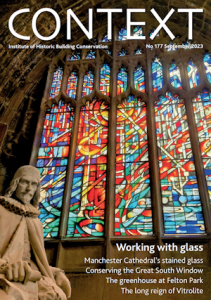 The new issue of the IHBC’s members’ journal, Context No. 177, explores how we can work with glass, with topics that range from Manchester Cathedral’s stained glass to the long reign of Vitrolite, alongside more including our regular features and the IHBC North-West Branch conference.
The new issue of the IHBC’s members’ journal, Context No. 177, explores how we can work with glass, with topics that range from Manchester Cathedral’s stained glass to the long reign of Vitrolite, alongside more including our regular features and the IHBC North-West Branch conference.
…For most of history, glass in buildings has meant windows…
The IHBC writes:
…Where aesthetics and technology meet…
‘That’s strange… I’m sure the architect assured us that the glass extension would be invisible.’
Such comments are often heard when a significant amount of glass has been used in adapting a historic building. The use of glass as a material for roofing and walling is relatively new. How such glass looks will depend on what sort of glass it is, how it is designed and detailed, and how the building is lit from within and without. In some circumstances glass can be almost invisible or transparent, but usually one can see both the material itself and its reflections. Its particular characteristics can make it successfully complement a historic building when designed by someone who understands the material and its potential for constructing roofs and walls.
For most of history, glass in buildings has meant windows. If modern glass is more than just glass, historic glass is also more than just glass. What the glass looks like from the outside and inside will depend on the technology with which it was made, whether cylinder, crown, plate, sheet, float or any other type of glass. That is part of the reason why it can be important to conserve historic glass, or to reglaze windows that have lost their glass with a historically appropriate replacement. Will anyone notice? Some will, and others will enjoy the building more without knowing how much its glass is contributing to its character.
Glass rarely survives a change of window (unless it is so valued that, as in the case of Canterbury Cathedral’s Great South Window, featured on page 18, fragments of ancient glass were reinstated in the past). Windows are among the most changeable features of a building, facing us with questions of when to conserve or replace, and what glass will be appropriate for the building. As Historic England advises, before we decide what to do, we need to know the form, materials and history of the windows, their significance and the impact of proposed changes.
Windows, like doors, are celebrated in architecture as the elements where inside and outside meet. That aesthetic function complements the practical ones. In addition to lighting the interior and providing views out, glass can let too much heat in, or too much heat out; and it will help to determine how much energy is used in constructing or adapting a building. As ever with historic buildings, glass is where aesthetics and technology meet.
Themed & Feature articles include:
- The history of glass in the UK and Ireland, Katia Papkovskaia
- Conserving the Great South Window, Jonathan Deeming
- Environmental protective glazing, Alison Gilchrist
- Celebrating the everyday in stained glass, Jeff Hopewell
- The abstract stained glass of Manchester Cathedral, Alexandra Fairclough
- The wrought-iron greenhouse at Felton Park, Edward Diestelkamp
- The long reign of Vitrolite, Katriona Byrne
- Upgrading metal windows for thermal comfort, Douglas Kent
Regular features include:
- Briefing
- The writer’s voice
- Letters
- IHBC North-West branch conference
- Periodically
- Legal update
- Notes from the chair
- Director’s cut
- Vox pop
- New member
- Book reviews
- Inter alia
- Products and services
- Specialist suppliers index
Reading Context helps IHBC members develop their skills across all of the IHBC’s Areas of Competence, and so is a critical baseline in addressing priorities in Continuing Professional Development (CPD)
Access the online archive and see the issue online
See more IHBC background and guidance on IHBC CPD and on how you might use past, current and future issues of Context
See the formal guidance paper on IHBC CPD (scheduled for update)
See more on the IHBC Competences and Areas of Competence

